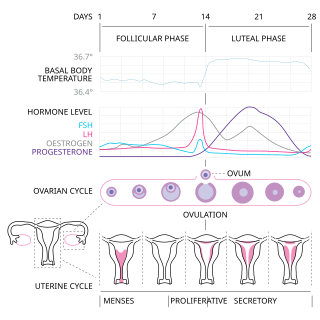Related Research Articles

Apoptosis is a form of programmed cell death that occurs in multicellular organisms and in some eukaryotic, single-celled microorganisms such as yeast. Biochemical events lead to characteristic cell changes (morphology) and death. These changes include blebbing, cell shrinkage, nuclear fragmentation, chromatin condensation, DNA fragmentation, and mRNA decay. The average adult human loses 50 to 70 billion cells each day due to apoptosis. For the average human child between 8 and 14 years old, each day the approximate loss is 20 to 30 billion cells.

Progesterone (P4) is an endogenous steroid and progestogen sex hormone involved in the menstrual cycle, pregnancy, and embryogenesis of humans and other species. It belongs to a group of steroid hormones called the progestogens and is the major progestogen in the body. Progesterone has a variety of important functions in the body. It is also a crucial metabolic intermediate in the production of other endogenous steroids, including the sex hormones and the corticosteroids, and plays an important role in brain function as a neurosteroid.

The menstrual cycle is a series of natural changes in hormone production and the structures of the uterus and ovaries of the female reproductive system that makes pregnancy possible. The ovarian cycle controls the production and release of eggs and the cyclic release of estrogen and progesterone. The uterine cycle governs the preparation and maintenance of the lining of the uterus (womb) to receive an embryo. These cycles are concurrent and coordinated, normally last between 21 and 35 days, with a median length of 28 days, and continue for about 30–45 years.

Estradiol (E2), also spelled oestradiol, is an estrogen steroid hormone and the major female sex hormone. It is involved in the regulation of female reproductive cycles such as estrous and menstrual cycles. Estradiol is responsible for the development of female secondary sexual characteristics such as the breasts, widening of the hips and a female pattern of fat distribution. It is also important in the development and maintenance of female reproductive tissues such as the mammary glands, uterus and vagina during puberty, adulthood and pregnancy. It also has important effects in many other tissues including bone, fat, skin, liver, and the brain.

Progestogens, also sometimes written progestins, progestagens or gestagens, are a class of natural or synthetic steroid hormones that bind to and activate the progesterone receptors (PR). Progesterone is the major and most important progestogen in the body. The progestogens are named for their function in maintaining pregnancy, although they are also present at other phases of the estrous and menstrual cycles.

A progestogen, also referred to as a progestagen, gestagen, or gestogen, is a type of medication which produces effects similar to those of the natural female sex hormone progesterone in the body. A progestin is a synthetic progestogen. Progestogens are used most commonly in hormonal birth control and menopausal hormone therapy. They can also be used in the treatment of gynecological conditions, to support fertility and pregnancy, to lower sex hormone levels for various purposes, and for other indications. Progestogens are used alone or in combination with estrogens. They are available in a wide variety of formulations and for use by many different routes of administration. Examples of progestogens include natural or bioidentical progesterone as well as progestins such as medroxyprogesterone acetate and norethisterone.
Hot flashes are a form of flushing, often caused by the changing hormone levels that are characteristic of menopause. They are typically experienced as a feeling of intense heat with sweating and rapid heartbeat, and may typically last from two to 30 minutes for each occurrence.
Bioidentical hormone replacement therapy (BHRT), also known as bioidentical hormone therapy (BHT) or natural hormone therapy, is the use of hormones that are identical on a molecular level with endogenous hormones in hormone replacement therapy. It may also be combined with blood and saliva testing of hormone levels, and the use of pharmacy compounding to obtain hormones in an effort to reach a targeted level of hormones in the body. A number of claims by some proponents of BHT have not been confirmed through scientific testing. Specific hormones used in BHT include estrone, estradiol, progesterone, testosterone, dehydroepiandrosterone (DHEA), and estriol.

Julie Carmen is an American actress, dancer and a licensed psychotherapist. She came to prominence onscreen in the 1980s and 1990s, for her roles in John Cassavetes’ Gloria (1980), Robert Redford’s The Milagro Beanfield War (1988) and John Carpenter’s In the Mouth of Madness (1995).
The Wiley Protocol is a form of bioidentical hormone replacement therapy (BHRT) devised and advocated by author T. S. Wiley. The protocol claims to relieve the symptoms of menopause but is also promoted as increasing overall health through the recreation of a pre-menopausal woman's monthly hormonal cycle using rhythmic doses of hormones standardized to a uniform purity. Wiley claims the protocol is a step beyond the symptomatic treatment of conventional hormone replacement therapy.
Bent Formby is a biochemist and researcher. He was born in Copenhagen, and came to the U.S. as a visiting professor in 1979. He co-authored two books and several articles on endocrinology with T. S. Wiley.
Hormone replacement therapy (HRT), also known as menopausal hormone therapy or postmenopausal hormone therapy, is a form of hormone therapy used to treat symptoms associated with female menopause. Effects of menopause can include symptoms such as hot flashes, accelerated skin aging, vaginal dryness, decreased muscle mass, and complications such as osteoporosis, sexual dysfunction, and vaginal atrophy. They are mostly caused by low levels of female sex hormones that occur during menopause.

Catamenial epilepsy is a form of epilepsy in women where seizures are exacerbated during certain phases of the menstrual cycle. In rare cases, seizures occur only during certain parts of the cycle; in most cases, seizures occur more frequently during certain parts of the cycle. Catamenial epilepsy is underlain by hormonal fluctuations of the menstrual cycle where estrogens promote seizures and progesterone counteracts seizure activity.

Nomegestrol acetate (NOMAC), sold under the brand names Lutenyl and Zoely among others, is a progestin medication which is used in birth control pills, menopausal hormone therapy, and for the treatment of gynecological disorders. It is available both alone and in combination with an estrogen. NOMAC is taken by mouth. A birth control implant for placement under the skin was also developed but ultimately was not marketed.

Suzanne Marie Somers was an American actress, author, and businesswoman. She played the television roles of Chrissy Snow on Three's Company (1977–1981) and Carol Foster Lambert on Step by Step (1991–1998).
Kent Holtorf is an American physician and entrepreneur practicing in Los Angeles, California. He is a board examiner of the American Board of Anti-Aging Medicine (ABAAM), which is not recognized by established medical organizations. He is the founder and medical director of Holtorf Medical Group, a practice with five centers that offer treatment for conditions including fibromyalgia, adrenal fatigue, complex endocrine dysfunction, hypothyroidism, age management, chronic fatigue syndrome, low libido, chronic Lyme disease, migraines, PMS, perimenopause and menopause. His practice focuses on alternative therapies that are not recognised as effective. He has been criticized in the media for his controversial views on topics like bioidentical hormone replacement therapy and vaccines.

Conjugated estrogens (CEs), or conjugated equine estrogens (CEEs), sold under the brand name Premarin among others, is an estrogen medication which is used in menopausal hormone therapy and for various other indications. It is a mixture of the sodium salts of estrogen conjugates found in horses, such as estrone sulfate and equilin sulfate. CEEs are available in the form of both natural preparations manufactured from the urine of pregnant mares and fully synthetic replications of the natural preparations. They are formulated both alone and in combination with progestins such as medroxyprogesterone acetate. CEEs are usually taken by mouth, but can also be given by application to the skin or vagina as a cream or by injection into a blood vessel or muscle.

Estradiol (E2) is a medication and naturally occurring steroid hormone. It is an estrogen and is used mainly in menopausal hormone therapy and to treat low sex hormone levels in women. It is also used in hormonal birth control for women, in feminizing hormone therapy for transgender women, and in the treatment of hormone-sensitive cancers like prostate cancer in men and breast cancer in women, among other uses. Estradiol can be taken by mouth, held and dissolved under the tongue, as a gel or patch that is applied to the skin, in through the vagina, by injection into muscle or fat, or through the use of an implant that is placed into fat, among other routes.

Progesterone (P4), sold under the brand name Prometrium among others, is a medication and naturally occurring steroid hormone. It is a progestogen and is used in combination with estrogens mainly in hormone therapy for menopausal symptoms and low sex hormone levels in women. It is also used in women to support pregnancy and fertility and to treat gynecological disorders. Progesterone can be taken by mouth, vaginally, and by injection into muscle or fat, among other routes. A progesterone vaginal ring and progesterone intrauterine device used for birth control also exist in some areas of the world.

The pharmacokinetics of progesterone, concerns the pharmacodynamics, pharmacokinetics, and various routes of administration of progesterone.
References
- ↑ Wiley, TS; Bent Formby (February 27, 2001). Lights Out: Sleep, Sugar, and Survival. Atria. ISBN 0-671-03868-0.
- 1 2 Wiley, TS; Julie Taguchi; Bent Formby (September 14, 2004). Sex, Lies, and Menopause: The Shocking Truth About Synthetic Hormones and the Benefits of Natural Alternatives. Harper Paperback imprint of HarperCollins. ISBN 0-06-054234-9.
- ↑ Formby, Bent; T.S. Wiley (1998). "Progesterone inhibits growth and induces apoptosis in breast cancer cells: inverse effects on Bcl-2 and p53". Ann Clin Lab Sci . 28 (6): 360–9. PMID 9846203.
- ↑ Formby, Bent; T.S. Wiley (1999). "Bcl-2, survivin and variant CD44 v7-v10 are downregulated and p53 is upregulated in breast cancer cells by progesterone: inhibition of cell growth and induction of apoptosis". Mol Cell Biochem . 202 (1–2): 53–61. doi:10.1023/A:1007081021483. PMID 10705995. S2CID 25532485.
- ↑ R Stern; S Shuster; TS Wiley; B Formby (2001). "Hyaluronidase can modulate expression of CD44". Exp Cell Res . 266 (1): 167–76. doi:10.1006/excr.2001.5206. PMID 11339835.
- ↑ Somers, Suzanne (2006). Ageless: The Naked Truth About Bioidentical Hormones . Crown Publishing Group. ISBN 0-307-23724-9.
- ↑ Schwartz, Erika; Schwarzbein, D.; et al. (October 11, 2006). "Letter to Suzanne Somers".
- ↑ Feig SA, Hynote E, Speight N, Magaziner A, Miranda RA, Schachter MA (September 2005). "Summary of the American College for Advancement in Medicine May 2005 Conference: Menopause, Andropause: Power in Transition". Evidence-Based Complementary and Alternative Medicine. 2 (3): 416. doi:10.1093/ecam/neh113. PMC 1193553 .
- ↑ Rosenthal MS (2008). "The Wiley Protocol: an analysis of ethical issues". Menopause . 15 (5): 1014–22. doi:10.1097/gme.0b013e318178862e. PMID 18551081. S2CID 196421747.
- 1 2 "A Real Somers Storm: At war over Suzanne Somers's book on 'bioidenticals'". Newsweek. November 13, 2006. Retrieved 2008-10-09.
- ↑ Sherr, Lynn; Glenn Ruppel (2007-02-16). "Suzanne Somers: Super Saleswoman: Has Somers Found the Fountain of Youth?". ABC News, 20/20. Retrieved 2008-10-09.
- ↑ Ellin, Abby (October 15, 2006). "A Battle Over 'Juice of Youth'". New York Times. Retrieved 2007-12-01.
- ↑ "Hearings: Bioidentical Hormones: Sound Science or Bad Medicine?". United States Senate Special Committee on Aging. April 19, 2007. Retrieved 2007-12-01.